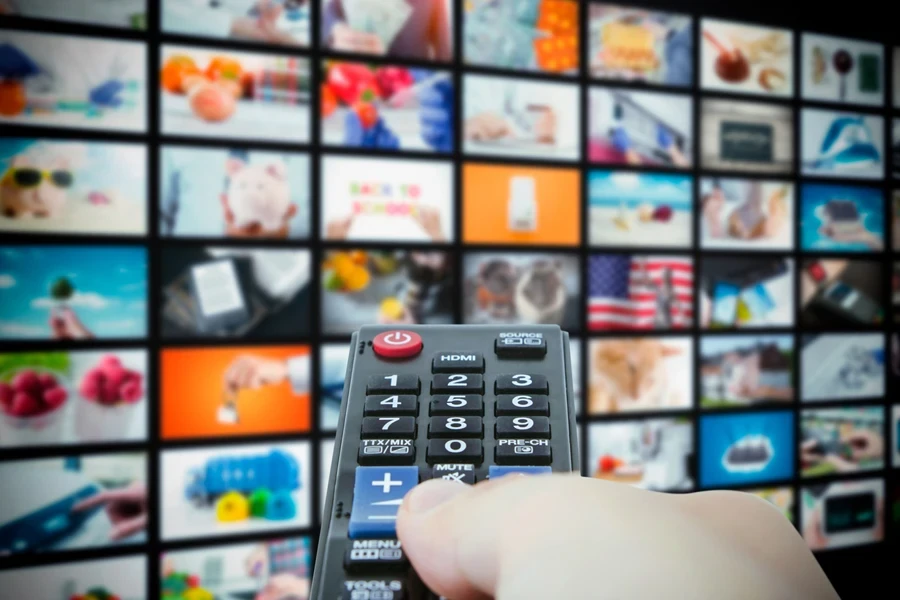TV display technologies are advancing rapidly, offering options like QLED, Crystal UHD, Mini LED, and Neo QLED. As each has distinct features, it’s essential for professional buyers to understand the differences.
This article focuses on QLED vs. Crystal UHD, comparing picture quality, brightness, and color accuracy to assist retailers in making the right stocking decision for 2025.
Table of Contents
QLED at a glance
Crystal UHD at a glance
Other display technologies worth mentioning
Comparing QLED and Crystal UHD
Conclusion
QLED at a glance

QLED (Quantum Dot Light Emitting Diode) is a display tech from Samsung that enhances brightness, color accuracy, and overall picture quality using quantum dots. A layer of these tiny semiconductor nanocrystals is placed between the LED backlit and the LCD screen.
QLED devices are known for their brighter colors, better contrast, and superior HDR performance. Their wider color gamut enhances contrast for deeper blacks and maintains superior color reproduction in bright rooms.
While there are variations in the market, Samsung’s QLED stands out for its innovations in models like the Neo QLED, which integrates with Mini LED technology for stellar performance.
Crystal UHD at a glance

Samsung’s 4K LED TVs, marketed under Crystal UHD (Ultra High Definition), are inexpensive and known for their clearer images.
Color accuracy and clarity are pegged on its conventional LED technology, augmented with Crystal Display technology. Crystal UHD TVs aren’t pricey and have premium extra features while aiming for good picture quality.
The 4K resolution (3840 x 2160 pixels) features an LED backlight and an LCD panel, guaranteeing crisp and clear graphics. Its Crystal Processor 4K optimizes picture quality and offers acceptable color performance, but it can’t compare to quantum dot technology’s sophisticated color modification.
Among the most notable characteristics of Crystal UHD TVs are their 4K resolution, fluid motion rate, and HDR compatibility, but to a lesser extent than in QLED. Smart capabilities for streaming and app use are standard on these TVs, but they can’t compete with the higher brightness and color depth of QLED.
Other display technologies worth mentioning

Here’s how other TV technologies compare to QLED and Crystal UHD:
Mini LED and Full Array LED
For more accurate backlighting, mini LED technology employs smaller LEDs than conventional LED panels. Thanks to thousands of these tiny LEDs, mini LED TVs deliver enhanced local dimming, deeper blacks, and higher contrast.
Reducing the size of the LEDs allows for finer control of screen brightness and contrast, leading to better overall image quality. When creating high dynamic range (HDR) content, this is handy since scene-to-scene brightness variations are pretty essential.
Instead of using LEDs along the edges, as in conventional edge-lit displays, full-array LEDs illuminate the entire screen from the rear. This configuration allows for local dimming, which lets you individually dim certain screen regions for improved contrast ratios and more lifelike shadows.
Neo QLED: The Next Step in QLED Evolution
Neo QLED is Samsung’s next step in developing QLED technology. Mini LED lights give you more control over brightness and contrast. Neo QLED provides better accuracy by mixing quantum dot technology with Mini LEDs, which makes highlights brighter and blacks deeper.
It also works great for high-dynamic-range (HDR) video, which needs to show fine details in dark and light scenes. Some of Neo QLED’s best features are better HDR performance, more accurate color rendering, and higher contrast ratios.
These changes make pictures more vivid and lifelike, especially in scenes with a lot of brightness variation. Neo QLED has better clarity in light and dark areas than regular QLED, which means problems like blooming and halo effects are less likely to happen.
Comparing QLED and Crystal UHD

Picture quality
Because of the quantum dot technology, QLED exceeds Crystal UHD in color accuracy and range. QLED’s quantum dots boost color vibrancy and accuracy, expanding its color gamut. This makes visuals more realistic, especially in bright scenes with vibrant colors.
Crystal UHD reproduces colors well, while QLED is more precise and intense, especially in saturated hues. Standard LED panels in Crystal UHD give decent color fidelity but lack QLED’s quantum dots’ brightness.
HDR QLED also excels in luminance. With the help of quantum dots and improved backlighting, QLED TVs have boosted peak brightness, improving HDR performance. QLED’s bright colors and better dynamic range make it ideal for HDR content.
Crystal UHD supports HDR but is less bright and performs less well than QLED, which provides a better visual experience for HDR movies and shows.
Local dimming and quantum dots give QLED higher contrast and deeper blacks than Crystal UHD. Traditional LED technology in Crystal UHD struggles to provide the same contrast, especially in dark environments. Poor dimming might wipe away Crystal UHD blacks.
In contrast, QLED TVs, especially those with Full Array Local Dimming (FALD), may modify individual illumination zones to produce darker blacks and greater contrast ratios, considerably improving picture depth.
QLED and Crystal UHD have weak viewing angles. When viewed off-center, QLED VA panels lose color accuracy and contrast. Crystal UHD, employing comparable panel technology, washes out colors at wider viewing angles.
Samsung’s Ultra Viewing Angle layer reduces this issue in higher-end QLED models. Without such upgrades, Crystal UHD models are less suitable for group watching from numerous perspectives.
Performance and processing power
Regarding response time and refresh rates, QLED TVs shine, especially those that are highly-priced. Many QLED models have 120Hz refresh rates, which improves performance in fast-paced scenarios like sports and action flicks.
This makes QLED ideal for gamers and fast-motion fans. However, crystal UHD TVs often have 60Hz refresh rates, which are fine for casual viewing but may cause lag during fast action scenes.
QLED’s Ultra Viewing Angle technology (in higher-end models) decreases color and contrast loss at wide viewing angles, making it somewhat better than Crystal UHD. QLED excels at color fidelity from varied angles in the room, although both technologies work well for standard viewing.
Smart features

Samsung’s QLED and Crystal UHD TVs run Tizen, its proprietary operating system, which has an easy-to-use interface, rapid navigation, and many streaming apps. App availability and usage are similar on both platforms, thus QLED and Crystal UHD customers won’t notice much difference.
Both QLED and Crystal UHD models have Bixby, Amazon Alexa, and Google Assistant for voice control and smart home connectivity.
Differences are more about model type than technology. High-end QLED models have smarter features like hands-free voice control and multi-device control, whereas entry-level Crystal UHD ones may not.
Design and build quality
Both the QLED and Crystal UHD TVs look sleek and modern, with thin edges and stylish stands. But QLED models, especially those in the high-end range, usually have better materials and more stylish designs.
Some QLED models also have an ambient mode that lets the TV blend in with your surroundings when it’s not being used. Crystal UHD TVs don’t usually have this feature.
The QLED and Crystal UHD models both have HDMI, USB, Ethernet, and optical audio outputs, as well as an equal number of ports. Some higher-end QLED models may have extra HDMI 2.1 ports, which let you play games at 120Hz and use other advanced features.
Most Crystal UHD models have standard HDMI 2.0 ports, which are fine for most users but might not be as future-proof as higher-end QLED versions.
Price comparison
Due to their quantum dot technology, brightness, and HDR capability, high-end QLED TVs cost more than Crystal UHD. Samsung’s Neo QLED brand of high-end QLEDs costs more than Crystal UHD TVs, but buyers get an unrivaled viewing quality.
Crystal UHD versions are cheaper and a decent value for individuals who want a 4K TV without QLED features. Crystal UHD TVs offer good performance and pricing, making them appealing to budget-conscious shoppers.
Value for money depends on user needs. If color accuracy, brightness, and HDR performance matter, QLED is worth the extra money. Crystal UHD delivers great value without premium features for those who mostly view regular 4K material and want a nice TV at a lesser cost.
Conclusion
QLED is perfect for premium watching due to its color accuracy, brightness, and HDR capabilities. Crystal UHD is a cheaper option with 4K resolution and good performance for entry-level users. QLED excels in local dimming and quantum dot technology, while Crystal UHD is a good choice for budget-conscious buyers who want good picture quality.
If you’re looking to bulk-buy QLED or Crystal UHD TVs, Alibaba.com offers a large selection of high-quality, affordable TVs for premium and budget markets.




